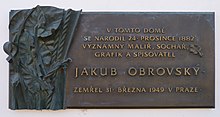Jakub Obrovský
Jakub Obrovský (born December 24, 1882 in Brno , † March 31, 1949 in Prague ) was a Czech painter, sculptor, graphic artist and writer.

Life
Obrovský was born the youngest of three sons to a farmer and showed talent from childhood. Supported in particular by his mother, he entered the arts and crafts school in Prague at the age of 15. From 1901 to 1905 he studied at the Academy of Fine Arts in Prague, among others with Celda Klouček , E. K. Liška and M. Pirner. After several months of study in Italy, which he owed a Hlávka scholarship, he mainly accepted decoration orders in Prague from 1908. So he designed the mosaic in the dining room of the Prague Municipal House , a ceiling of the castle in Libeň , frescoes for the law faculty in Prague and the church in Bohnice .
In the years 1911 to 1913 he turned to oil painting , especially female figures from the gypsy milieu . The most famous work from this period is probably the "Gypsy Madonna" . With the great acceptance of his oeuvre came the social advancement combined with membership in important committees. In 1911 he became a member of the Vienna Hagenbund , in 1912 with the Czech section of the Board of Trustees of the Modern Gallery, in 1913 of the Bohemian Academy of Sciences and Art , and in 1919 of the Société nationale des beaux-arts (SNBA) in Paris . In 1919 he became professor at the Academy of Fine Arts in Prague and from 1935 to 1937 its rector.
Obrovský was already interested in sculpture during his studies, but it was only from 1923 - under the influence of Antoine Bourdelle - that he began to deal systematically with sculpture . His main motives were athletes. Figures from antiquity and female nudes , which he created mainly from marble and bronze. The first editions of Czechoslovakian stamps with legionnaires' motifs should be mentioned from Obrovský's graphic work . Some stories in which he draws from memories of his idealized childhood have also been preserved.
honors and awards
- For his sculpture "Odysseus" Obrovský received the bronze medal in the field of "round sculptures" at the art competitions of the X Summer Olympics in Los Angeles in 1932
- For the monumental bronze sculpture "The Murdering Odysseus" (1934–35) he received the Katz Prize of the Bohemian Academy of Sciences and Art.
- A street was named after him in the Bystrc district of Brno and at the end of it there was a monument to him by Miloš Axman in a park .
literature
- V. Kratinová: Obrovský Jakub. In: Austrian Biographical Lexicon 1815–1950 (ÖBL). Volume 7, Verlag der Österreichischen Akademie der Wissenschaften, Vienna 1978, ISBN 3-7001-0187-2 , p. 201.
Web links
Individual evidence
| personal data | |
|---|---|
| SURNAME | Obrovský, Jakub |
| BRIEF DESCRIPTION | Czechoslovakian painter, sculptor, printmaker and writer |
| DATE OF BIRTH | December 24, 1882 |
| PLACE OF BIRTH | Brno |
| DATE OF DEATH | March 31, 1949 |
| Place of death | Prague |
